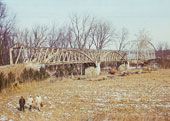Covered Bridges
(Click on a photo to see the image close-up.) Americans hold covered bridges near and dear, endowing them with a lot of nostalgia and romance. Parke County, Indiana, has built a significant tourism industry around its covered bridges, and Robert James Waller, who received a PhD in business from IU in 1968, wrote a best-selling novel, The Bridges of Madison County, about them. To Warren, the covered bridge was anything but old-fashioned. It was a physical manifestation of the transitional period between the Old Traditional Way of Life and modern society. As part of what Warren called the “rebuilding of America,” it represented the development of the modern road system, and, of course, the modern transportation system, both of which were falling under the control of local government. Local farmers were no longer deciding where and what kind of bridges to build. Instead, the board of county commissioners now selected a bridge’s location, design, cost, even the contractor. Located just south of the town of Freedom in Owen County, Indiana, the two-span Freedom Bridge shown above, upper left, was dismantled in 1966, with one span moved to the museum storage area at Indiana University. The Burr arch bridge, erected in 1882, spanned a gravel country road over bottomlands of the West Fork of the White River. The covered bridge was attached to a steel Pennsylvania through-truss that carried the road over the river. In 2002, this truss was moved to Connor Prairie, Indiana’s premier living history museum, where it serves as the link between an 1886 farm and a 1936 farm. Check out these interesting links: Parke County Connor Prairie Indiana Covered Bridge Society |








